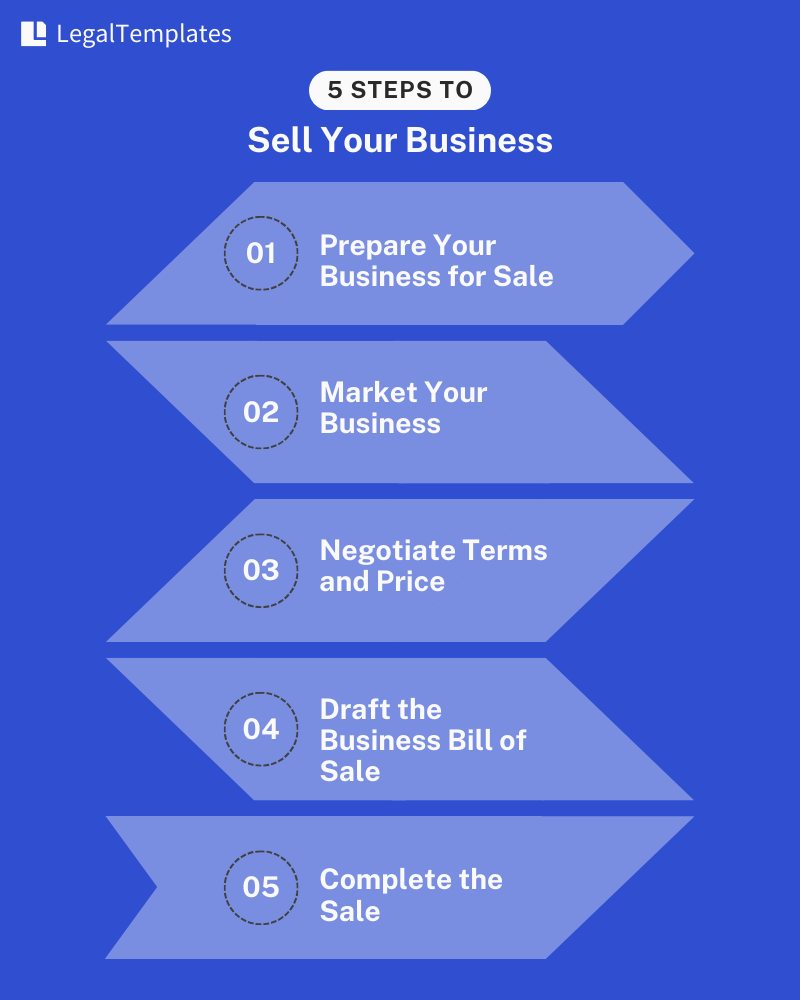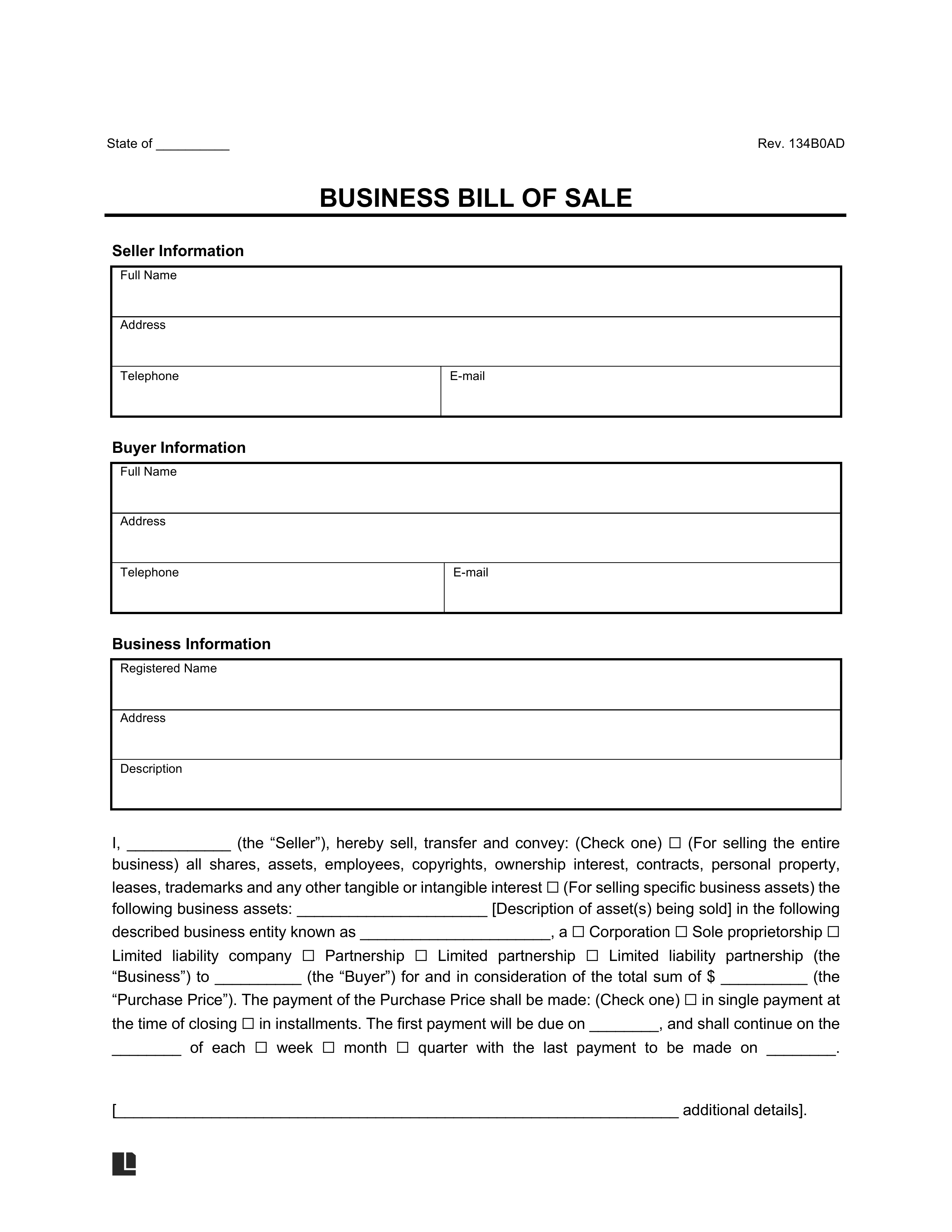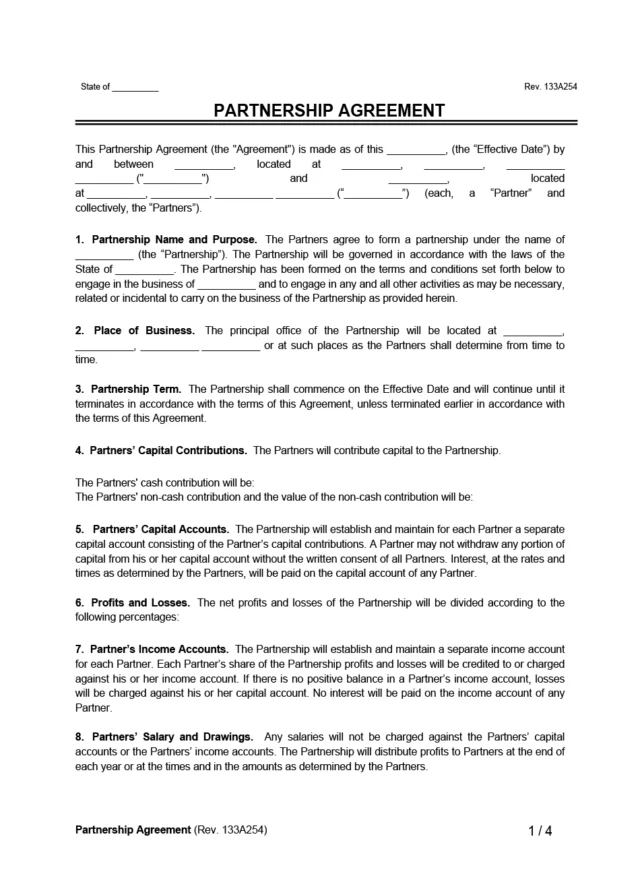A business bill of sale is essential for legally finalizing business transactions, serving as proof of ownership transfer. It details the agreement terms, including the purchase price, and may cover stock or asset transfers and the seller’s future role. It’s necessary for transferring licenses and permits and preventing ownership disputes.
When to Use
- Selling a Small or Mid-Sized Business: Finalize the sale and transfer ownership.
- Transferring Business Assets: Sell specific assets like equipment, inventory, or intellectual property.
- Stock or Share Sales: Formalize the transfer of shares in a company.
- Business Mergers: Document the sale of a business as part of a merger or acquisition.
- Proof of Ownership Transfer: Provide legal documentation of the transfer for tax, licensing, or registration purposes.
How Do I Sell My Business

If you’re selling a small to medium-sized business, a Business Bill of Sale is a key document that ensures the smooth transfer of ownership. Here’s a step-by-step guide to help you navigate the process:
Step 1 – Prepare Your Business for Sale
Before listing your business for sale, it’s important to ensure it is attractive to potential buyers.
- Organize Financial Records: Gather all relevant financial documents, including profit/loss statements, tax returns, and bank statements. Buyers for small businesses want transparency in financial health.
- Business Valuation: A professional valuation can help you clearly understand your business’s worth. While large corporations may have complicated valuation processes, small businesses can often use simpler methods available through services like BizEquity or ValueSource.
- Tidy Up Operations: Streamline your business operations to make them more appealing to buyers. Before putting the business on the market, consider addressing any outstanding debts, legal disputes, or inefficiencies.
Documents Required During a Business Sale
Here is a list of some of the most common documents necessary when selling a business:
- Records of all assets that are part of your business
- Operating manuals
- List of employees and payroll obligations
- Revenue records and completed tax forms for the past 3-4 years
- Financial statements
- Bank statements
- Pictures of your business and its assets
- Non-disclosure forms
- Licenses and permits
- Insurance records
- Client, supplier, and vendor contracts
Step 2 – Market Your Business
For smaller businesses, finding a buyer can be more localized and focused on a specific type of buyer, such as entrepreneurs or competitors in your industry.
- Business Listings: Consider advertising your business on platforms tailored to small and medium-sized businesses. Some of the most popular sites include:
- Work with a Business Broker: If you want assistance finding a buyer, hiring a business broker can help you reach a wider audience, especially for local sales. A broker can help vet potential buyers and speed up negotiations.
- Non-Disclosure Agreement (NDA): To protect sensitive information, buyers should ensure they sign an NDA before sharing key details like financial statements and client lists.
Step 3 – Negotiate Terms and Price
Negotiations when selling a small business tend to be less complex than those for larger companies, but key elements like the price and assets involved still need to be considered.
- Price and Assets: Most buyers of small businesses will want clear terms on what is included in the sale. This often involves equipment, inventory, intellectual property, and customer contracts.
- Simple Sale Structure: For smaller businesses, the sale is usually straightforward—often structured as an asset sale. In this case, the buyer purchases tangible assets like property and inventory rather than assuming the entire company’s liabilities.
Step 4 – Draft the Business Bill of Sale
Once terms are agreed upon, the business bill of sale becomes the crucial document that formalizes the transfer of ownership.
-
Ensure to include:
- Business details: Include the business name, location, and description of the assets being sold.
- Sale price: Clearly define the final price and payment terms.
- Signatures: Both buyer and seller should sign, with a witness or notary present, for added security.
Step 5 – Complete the Sale
Once the business bill of sale is signed, the business officially changes hands. Here are the final steps:
- Transfer of Ownership: Transfer any necessary licenses, permits, or registrations to the new owner. Ensure that all assets listed in the bill of sale are transferred correctly.
- Notify Employees, Vendors, and Customers: Communicate the change in ownership to all relevant parties, including employees, suppliers, and key customers.
- Final Payments and Handover: Ensure the buyer completes the final payment and that all agreed-upon assets are delivered.
Business Bill of Sale vs. Business Purchase Agreement
A business bill of sale and a business purchase agreement serve different purposes in the business transaction process. The latter is used early in negotiations, outlining the structure, potential sale items, and conditions, acting as a draft for the future business bill of sale.
It’s key for negotiating terms and setting the stage for the eventual sale. Once agreed-upon conditions are met, the transaction moves towards finalization with a business bill of sale, which is a formal document detailing the agreed terms of the sale.
| Business Bill of Sale | Business Purchase Agreement | |
|---|---|---|
| Purpose | Finalizes the sale and transfer of business ownership | Negotiates terms for a future sale or purchase of a business |
| Usage Stage | Used at the completion of the sale | Used in the initial negotiation stage |
| Document Type | Formal legal document detailing final sale terms | Draft or outline of sale conditions |
| Contents | Includes agreed-upon price, assets, liabilities, and ownership transfer details | Suggests prices, assets, and terms for negotiation |
| Conditions | Confirms that conditions are met and finalizes the transfer | Lists conditions that must be met before the final sale |
| Function | Transfers legal ownership and assets to the buyer | Lays the groundwork for future sale agreements |
How to Write a Business Bill of Sale
Follow these steps to write a comprehensive business bill of sale:
Step 1 – Complete Basic Information on Buyers and Sellers
- Date of Sale: Include the date when the sale is finalized, not when the document is created.
- Buyer Information: List the legal name and mailing address of the buyer.
- Seller Information: List the legal name and mailing address of the seller.
Step 2 – Detail Company Information
- Business Name: Include the legal name of the business.
- State of Incorporation: Specify the state where the business is legally formed.
- Headquarters Address: Provide the main office location.
- Assets, Shares, and Property: Clearly outline all assets, shares, or interests included in the sale.
Stock vs Asset Sale
If the sale involves shares or interests (stock sale), the buyer assumes more liability for pre-sale obligations (e.g., warranties, taxes). For an asset sale, the buyer can negotiate specific assets and limit liability, though the process may involve more documentation.
Step 3 – Include the Purchase Price
- Purchase Price: Clearly state the final agreed-upon price of the business.
- Payment Terms: Include any specific payment schedules or conditions agreed upon by both parties.
Step 4 – Specify the Date of Money Transfer
- Indicate when the funds will be transferred and when formal ownership will change hands.
Step 5 – Sign, Witness, and Notarize
- Signatures: Ensure both the buyer and seller sign the bill of sale.
- Witnesses: Have at least one witness document the signing, including their name, signature, and date.
- Notarization: Have the document notarized in the presence of a public notary to officially acknowledge the signatures.
Business Bill of Sale Sample
A business bill of sale template is an easy, convenient way to complete the necessary legal documentation. The template below includes all the information needed to finish your transaction.





